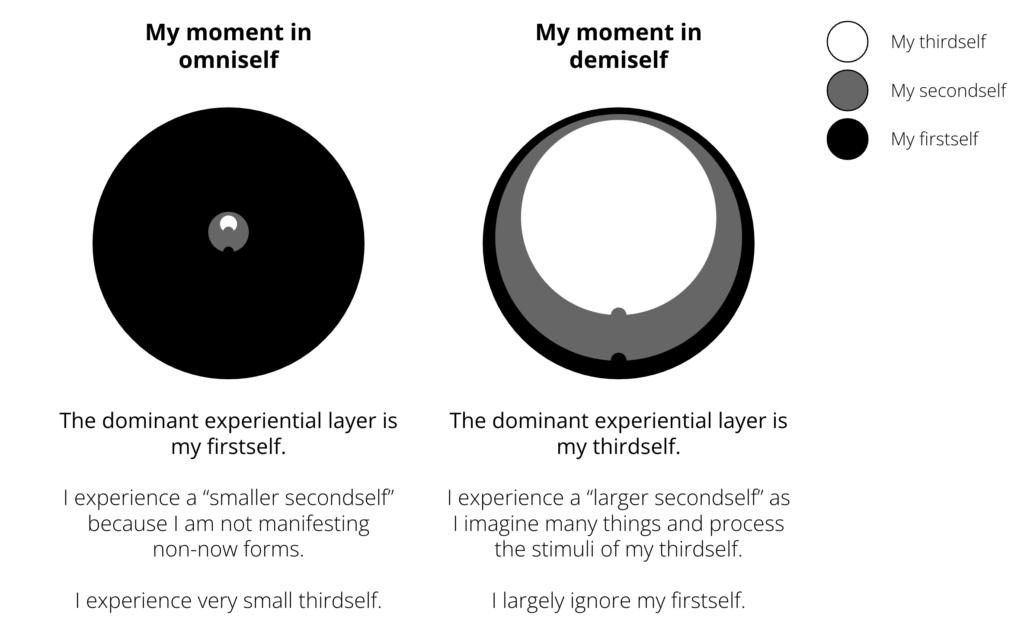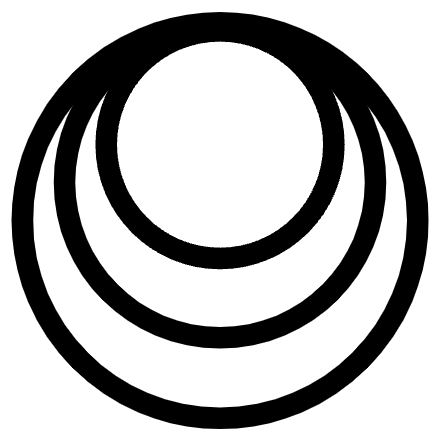My moment is the most important feature of the truth, and if I can visualize and understand it, then I can begin to tear down some of the most persistent distortions of my awakening. I am constantly searching for the most concise way to explain the nature of my moment. What is my moment? My moment is exactly that: this never-ending, present now. Not the contents which seem to continuously change, but the window in which my entire experience occurs. In the triself model, my moment is one aspect of my firstself.
The problem with my moment is that, while the fact that I have only one never changes, the contents of it are continuously in motion. It is this dichotomy that evades simple characterization. To arrive at a simple and precise description of my moment, I imagine two versions of it, keeping in mind that it extends in precisely two dimensions: my thirdself dimension of space and visual stimulation, and my secondself dimension of thoughts, feelings, desires, and non-visual but physical sensations (i.e., those sensations I feel within but cannot perceive without).
In the first variation of my moment, I am awake and I sit in a completely dark room without any thirdself visual forms. In a state of deep silence and meditation, my secondself is also constrained and I am focused entirely on my breathing.
In the second variation of my moment, I am in a bright city plaza full of people, sights, and sounds. I am busily making plans to visit various landmarks around the city with a group of friends.
Both of these situations are identical in only one way: they both occur in my moment. What is the difference between these two variations of the same moment? The secondself and thirdself contents. In one, my secondself is empty and still, and in the other it is busily planning and imagining. In one, my thirdself is completely dark and without any visual detail, and in the other it is full of a spectrum of colors, people, and forms all in motion.
So the moment has not changed, but the contents have. In the first, I am entirely focused on my present moment, but in the second my secondself is extended into an imaginary past and future as I plan my trip around the city, calling on my memories, desires, and creativity to stitch together a memorable experience for my group of friends. I can visualize these two variations of my moment in the aswaswas.

The important thing to note by this diagram is that my existence has not changed between the two. My firstself remains consistent in size and quality (infinite, both); it is only my two inner selves which appear to change, indicating the aforementioned motion and movement. The motion that seems to occur within my moment is an artifact of confusion, rendered familiar. Yet somehow I know that something is wrong; that I am missing something important. Pain persists, but the source of it is unclear.
In demiself, when I am performing personhood, I am not moving through time, but rather I am stationary and experiencing a multitude of distortions, one of which is time. In my darkened room meditating, I am standing in still water with little movement, allowing me to see through the calm waters to the ground. But in the noisy city plaza the waters of my secondself and thirdself are roiling as I move in all directions to satisfy my desires. Consequently, the waters refract and distort all light and I am unable to see what lies below.
Time is a distortion of my moment. My memories are not impressions of previous moments, but rather distortions of my present moment. The distortions are predicated on my belief that I am something other than I actually am; that I desire something to be whole, and then my subsequent motion to satisfy that desire. I think I have lost something, and am frantically searching for it, my movement only creating more chaos and confusion. My continuous movement is the cause of my confusion. My identity as a person experiencing a larger world rather than the creator of the delusion of a world is the source of all time. If I think I am a person experiencing a temporary life, then I will behave as such, creating the distortions in the flesh of my firstself, which gives rise to my secondself and thirdself.
I have lost something: myself. I have forgotten who I am. I can only look at myself, for I am all there is. But in moving I create new forms that I am not, like cutting off my fingers and toes. Each time I declare that this is not me, or that is not me, I cut off a piece of my flesh. There is only me; I am all there is. My moment is the light on the porch of my Home that I have left on. I only have to focus on it, let go, and I will come back to it.
…
